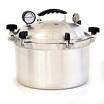1. PRESSURE DIAL GAUGE
The pressure dial gauge registers pressure in both pounds (outer scale) and metric measure (inner scale). The pointer moves around the dial indicating the pressure within the unit. The dial gauge is a delicate instrument which must be handled with care. Before first use, it will be necessary to assemble the dial gauge properly and attach it to the canner cover. The pressure dial gauge needs to be checked for accuracy prior to each canning season and if any of the following conditions exist: cover has been submerged in water or dropped, gauge glass is broken or has fallen out, parts are rusty, pointer is not in the “0” block, or if you believe the gauge may not be accurate.The gauge can usually be checked at your local county extension office. If you are unable to have your dial gauge checked locally, carefully
remove and package the gauge and send it to the Presto Consumer Service Department. See Service Information on page will be posts. An accurate gauge is necessary to help prevent food spoilage and possible food poisoning.
2. PRESSURE REGULATOR
The pressure regulator is a solid one-piece unit. Pressure readings on the pressure
canner are registered only on the pressure gauge (see above) and can be controlled and maintained by adjusting heat settings.
3. VENT PIPE
The pressure regulator fits over the vent pipe and allows excess pressure to be released.
4. AIR VENT/COVER LOCK
The air vent/cover lock automatically “vents” or exhausts air from the canner and acts as a visual indication of pressure in the canner. The small gasket must be in place for the air vent/cover lock to seal completely.
5. LOCKING BRACKET
The locking bracket on the inside of the canner body engages with the air vent/cover lock to prevent the cover from being opened when there is pressure in the unit.
6. SEALING RING
The sealing ring fits into the canner cover and forms a pressure-tight seal between the cover and body during canning and cooking.
7. OVERPRESSURE PLUG
The overpressure plug is located in the canner cover. It will automatically pop out and release steam in case the vent pipe becomes blocked and/or clogged and pressure cannot be released normally.
8. CANNING-COOKING RACK
The canning-cooking rack is placed in the bottom of the canner to hold jars off the bottom of the unit while canning. When cooking, the rack is used for steaming foods. It can also be used to hold foods such as vegetables out of the cooking liquid which allows several foods to be cooked at the same time without an intermingling of flavors. When it is desirable to blend flavors, do not use the canning-cooking rack. The canning-cooking rack must always be used when canning.
pressure canner
>>>>Read More....Click Here

 And the food quality and storage time is better with a
And the food quality and storage time is better with a  A dial gauge canner has a pressure dial on the top that allows you to read the pressure inside the canner during the canning process. Dial gauges operate from 0- to 25-pounds of pressure, with most recipes and
A dial gauge canner has a pressure dial on the top that allows you to read the pressure inside the canner during the canning process. Dial gauges operate from 0- to 25-pounds of pressure, with most recipes and  home gardeners and others agape in providing food cover charge for their families where quality control of the food is in one's own hands. Home food preservation also promotes a perplex of particular ease and endeavor. Further, the guess-work is taken out of being able to provide a unconvincible food supply at home whilst guidelines for inaction a
home gardeners and others agape in providing food cover charge for their families where quality control of the food is in one's own hands. Home food preservation also promotes a perplex of particular ease and endeavor. Further, the guess-work is taken out of being able to provide a unconvincible food supply at home whilst guidelines for inaction a 